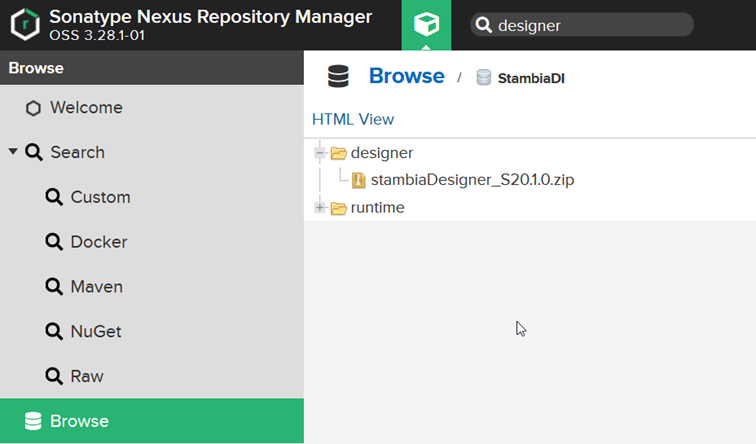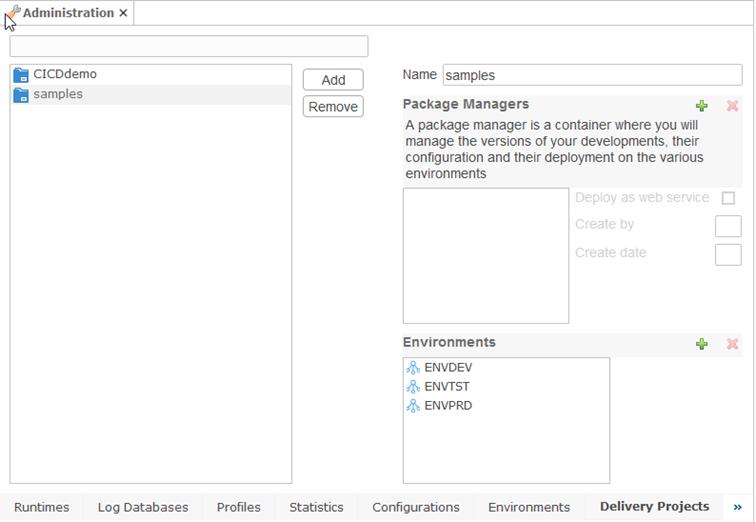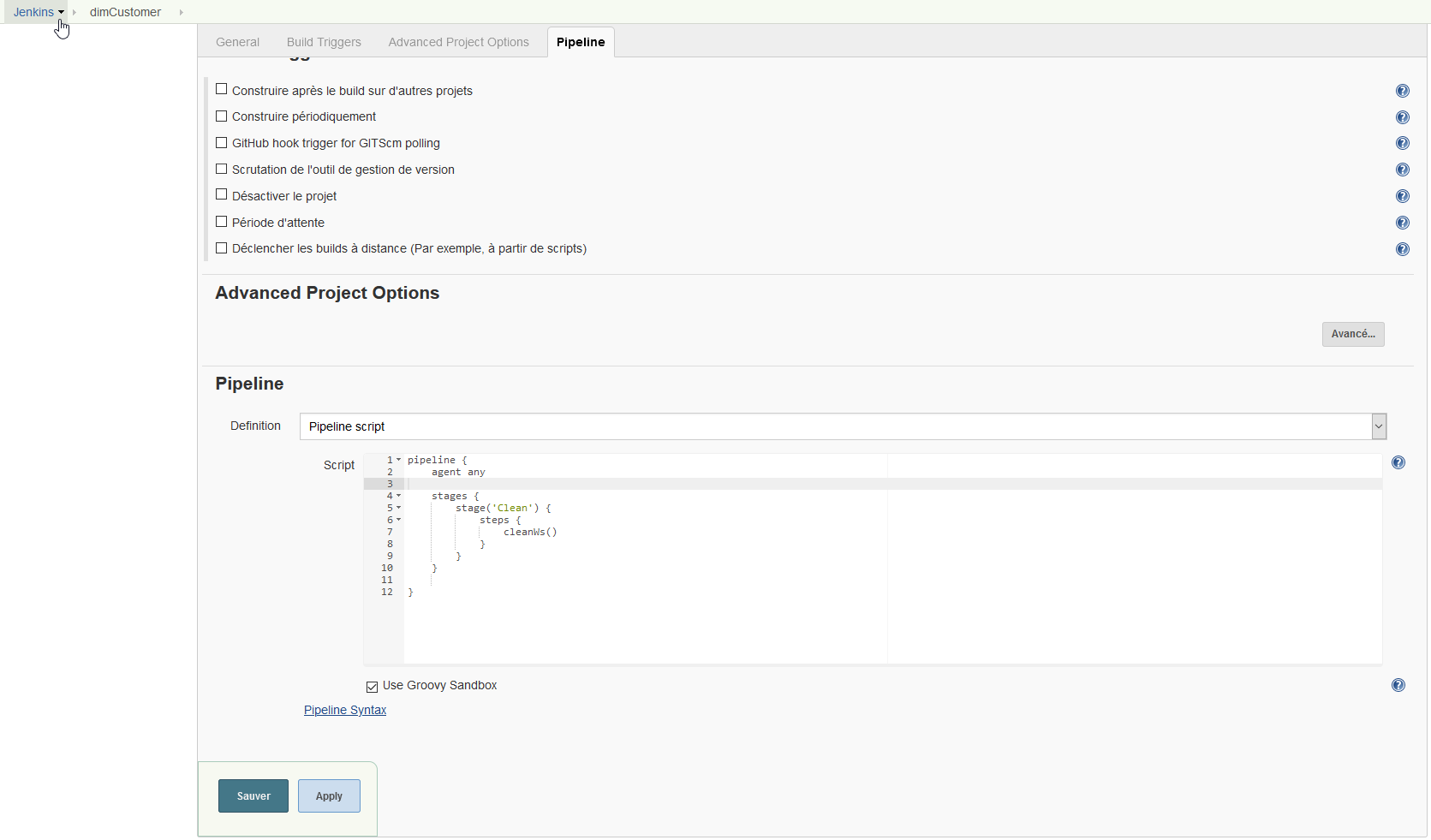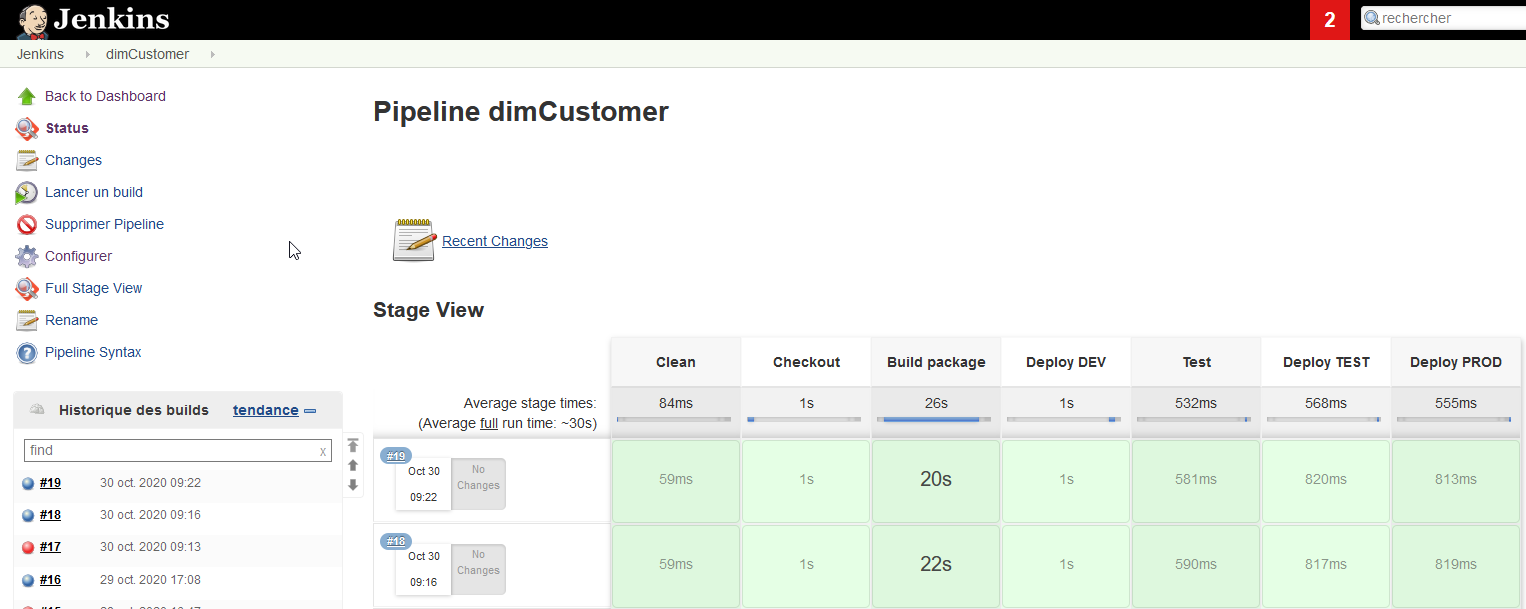Following the devOps principles, more and more organizations are building CI/CD chains to shorten the systems development life cycle and provide continuous delivery with high software quality.
The delivery of a new version of development made in Stambia can be seen as a four-steps process :

We will see in this article how Stambia can be integrated in a CI/CD chain using Jenkins, by deploying a sample application.
In this example, we will automate the build from sources to deployment on existing runtimes, using Jenkins as automation server and Stambia Production Analytics for the configuration management and deployment

Prerequisites
GitHub account : You need a GitHub account to fork/clone the sample repository
Jenkins server : To automate the tasks
Nexus repository : To store the Stambia Designer for building
Stambia environment : Stambia Production Analytics and 3 runtimes for Development, Test and Production, plus Hotel and Datamart demo databases.
Sample application overview
The sample application launchDimCustomer is made of a simple process calling loadDimCustomer mapping, which loads data from customer table of Hotel database to Datamart database.

A lauchDimCustomer script is included in the project, to build the launchDimCustomer.pck package file.
You can clone this project ‘dimCustomer’ from github repository : https://github.com/stambia/samples
Environment setup
We will first upload the stambia designer zip file – the one you can download from Stambia.org- to a nexus raw repository :

The resulting download URL will be http://nexus:8081/service/rest/v1/search/assets/download?name=designer/stambiaDesigner_S20.1.0.zip
We will create a delivery project named ‘samples’ in analytics as a placeholder for the package to deploy on environments ENVDEV, ENVTST, ENVPRD :

Other useful information used later in this example :
Analytics API URL : http://analytics:8080/analytics/services/api/2/
Analytics environment names for deployment : ENVDEV, ENVTST, ENVPRD
Build the pipeline
Now that everything is in place, we can create the Jenkins pipeline to automate the deployment tasks.
Create a pipeline project ‘dimCustomer’ :

Once created, we can create the pipeline script skeleton and set the environment variables :

Add the variables
pipeline {
agent any
environment {
NEXUS_USER = 'nexus_user'
NEXUS_PASSWORD = 'nexus_password'
STB_PROJECT = 'dimCustomer'
PKG_NAME = 'dimcustomer'
PKG_FILE = 'launchDimCustomer.pck'
PKG_VERSION = '1.0'
ANALYTICS_BASE_URL = 'http://analytics:8080/analytics/services/api/2'
ANALYTICS_USER = 'analytics_user'
ANALYTICS_PWD = 'analytics_password'
ANALYTICS_AUTH = 'base64_auth_chain'
DELIV_PROJECT = 'samples'
}
stages {
stage('Clean') {
steps {
cleanWs()
}
}
}
}
We can now add the necessary steps to build our pipeline, from the sources retrieval to the deployment on the three target environments
Checkout stage
Get the sources from the github repository :
git https://github.com/stambia/samples
Download the designer zip file :
sh 'curl -X GET -L --user "${NEXUS_USER}:${NEXUS_PASSWORD}" http://nexus:8081/service/rest/v1/search/assets/download?name=designer/stambiaDesigner_S20.1.0.zip -o designer.zip'
Build package stage
Unzip the designer :
sh 'unzip ${WORKSPACE}/designer.zip -d ${WORKSPACE}'
Build package using script file :
sh 'java -Djava.util.Arrays.useLegacyMergeSort=true -jar ${WORKSPACE}/stambia/plugins/org.eclipse.equinox.launcher_1.5.100.v20180827-1352.jar -application com.indy.shell.application -data "." -script "${WORKSPACE}/${STB_PROJECT}/Build/Scripts/launchDimCustomer" -console -noSplash -importFrom "${WORKSPACE}/${STB_PROJECT}" -cleanProjects -rebuildCache'
Deploy to development stage
Analytics API will be used here to :
- Create the package
sh 'curl -X POST --user "${ANALYTICS_USER}:${ANALYTICS_PWD}" "${ANALYTICS_BASE_URL}/project/${DELIV_PROJECT}/package/${PKG_NAME}"'
- Create the version ‘1.0’
sh 'curl -X POST --user "${ANALYTICS_USER}:${ANALYTICS_PWD}" "${ANALYTICS_BASE_URL}/project/${DELIV_PROJECT}/package/${PKG_NAME}/version/1.0" -H "accept: application/json"'
- Upload the package file
sh 'curl --location --request PATCH "${ANALYTICS_BASE_URL}/project/${DELIV_PROJECT}/package/${PKG_NAME}/version/1.0" --header "Authorization: Basic ${ANALYTICS_AUTH}" --form "fileUpload=@${WORKSPACE}/${PKG_FILE}"'
- Build and deploy the launchDimCustomer app
sh 'curl -X POST --user "${ANALYTICS_USER}:${ANALYTICS_PWD}" "${ANALYTICS_BASE_URL}/project/${DELIV_PROJECT}/package/${PKG_NAME}/environment/ENVDEV/version/1.0/working"'
sh 'curl -X POST --user "${ANALYTICS_USER}:${ANALYTICS_PWD}" "${ANALYTICS_BASE_URL}/project/${DELIV_PROJECT}/package/${PKG_NAME}/environment/ENVDEV/version/1.0/build"'
sh 'curl -X POST --user "${ANALYTICS_USER}:${ANALYTICS_PWD}" "${ANALYTICS_BASE_URL}/project/${DELIV_PROJECT}/package/${PKG_NAME}/environment/ENVDEV/version/1.0/deploy"'
Test stage
We are using the startCommand utility from the designer’s embedded runtime to execute delivery on the development runtime runtimeDEV on RMI port 42000 :
dir("${WORKSPACE}/stambia/stambiaRuntime/") {
sh './startcommand.sh "connect to runtimeDEV port 42000;execute delivery ${DELIV_PROJECT}/${PKG_NAME}/launchDimCustomer"'
Deploy to test and production stages
Then we can deploy to test and production environments using the same steps as for development, changing the environment name :
sh 'curl -X POST --user "${ANALYTICS_USER}:${ANALYTICS_PWD}" "${ANALYTICS_BASE_URL}/project/${DELIV_PROJECT}/package/${PKG_NAME}/environment/ENVTST/version/1.0/working"'
sh 'curl -X POST --user "${ANALYTICS_USER}:${ANALYTICS_PWD}" "${ANALYTICS_BASE_URL}/project/${DELIV_PROJECT}/package/${PKG_NAME}/environment/ENVTST/version/1.0/build"'
sh 'curl -X POST --user "${ANALYTICS_USER}:${ANALYTICS_PWD}" "${ANALYTICS_BASE_URL}/project/${DELIV_PROJECT}/package/${PKG_NAME}/environment/ENVTST/version/1.0/deploy"'
sh 'curl -X POST --user "${ANALYTICS_USER}:${ANALYTICS_PWD}" "${ANALYTICS_BASE_URL}/project/${DELIV_PROJECT}/package/${PKG_NAME}/environment/ENVPRD/version/1.0/working"'
sh 'curl -X POST --user "${ANALYTICS_USER}:${ANALYTICS_PWD}" "${ANALYTICS_BASE_URL}/project/${DELIV_PROJECT}/package/${PKG_NAME}/environment/ENVPRD/version/1.0/build"'
sh 'curl -X POST --user "${ANALYTICS_USER}:${ANALYTICS_PWD}" "${ANALYTICS_BASE_URL}/project/${DELIV_PROJECT}/package/${PKG_NAME}/environment/ENVPRD/version/1.0/deploy"'
Test the pipeline
That’s it, we can now test the entire chain in Jenkins

We can also check the execution logs of the test step using for example Production Analytics...

...and the package V1.0 creation and deployment :

The version 1.0 of launchDimCustomer app is now available in Production !
You can find the full pipeline script here : document Pipeline script (4 KB)


